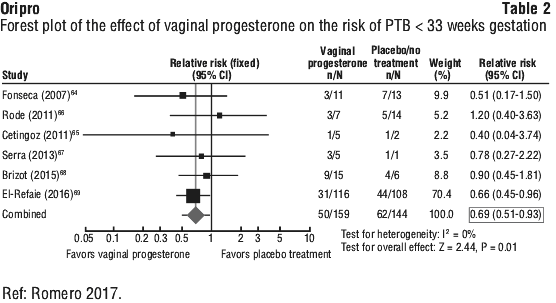What is in this leaflet
This leaflet answers some common questions about Oripro.
It does not contain all the available information.
It does not take the place of talking to your doctor or pharmacist.
All medicines have risks and benefits. Your doctor or pharmacist has weighed the risks of you taking Oripro against the benefits they expect it will have for you.
If you have any concerns about taking this medicine, ask your doctor or pharmacist.
Keep this leaflet with the medicine. You may need to read it again.
What Oripro is used for
Oripro is specially made to insert in your vagina. They contain a female hormone called progesterone.
Oripro can be given to women undergoing fertility treatment. Progesterone is a hormone essential for maintaining pregnancy. If you are having fertility treatment and your doctor has determined your body does not produce enough progesterone they may prescribe Oripro.
The progesterone will help prepare your uterus to receive and maintain a fertilized egg. Once pregnancy occurs, Oripro may be used until production of progesterone by the placenta is adequate.
Your doctor may prescribe Oripro 200 mg from the second trimester of your pregnancy, to prevent you going into labour too early. Oripro will not be prescribed to prevent early labour if you are expecting more than one baby.
Oripro is not addictive.
This medicine is available only with a doctor’s prescription.
Oripro is not recommended in children, as the safety and effectiveness of progesterone in this age group has not been established.
Before you use Oripro
When you must not use Oripro:
Do not use Oripro if you have an allergy to progesterone or any of the ingredients listed at the end of this leaflet.
Symptoms of an allergic reaction to progesterone may include:
- shortness of breath, wheezing or difficulty breathing
- swelling of the face, lips, tongue or other parts of the body
- skin rash, itching or hives
Do not use Oripro if you have or have had any of the following medical conditions:
- undiagnosed vaginal bleeding
- undiagnosed urinary tract bleeding
- active blood clotting (thrombophlebitis or thrombo-embolic disorder), such as, inflammation of a vein, deep vein blood clotting (thrombosis), or a blood clot that travelled to the lungs (pulmonary embolism)
- a history of hormone associated thrombophlebitis or thrombo-embolic disorder,
- liver dysfunction or disease
- malignancy or tumours, known or suspected of breast or genital organs
- pregnancy (when normal progesterone levels are present)
- missed abortion
Do not use Oripro if you are pregnant and have normal progesterone levels unless your doctor tells you to:
Progesterone is not recommended for use in normal pregnancy unless your doctor prescribes it from your second trimester to prevent preterm labour.
Where progesterone levels are insufficient or low and you and your doctor have discussed the risks and benefits involved, as in assisted reproductive procedures, Oripro is used to support embryo implantation, to instigate and maintain initial pregnancy. No adverse effects have been reported when used in this manner.
Do not use Oripro if you are breast-feeding or plan to breast-feed:
Progesterone passes into the breast milk in variable amounts and may affect the quantity of breast milk. The effect of the progesterone on the breast feeding infant is not known.
Do not give or use Oripro to a child of any age. The safety and effectiveness of progesterone use in children has not been established.
Do not use Oripro after the expiry date printed on the pack.
Do not use Oripro if the packaging is damaged or shows signs of tampering or the product does not look quite right. If it has expired or is damaged, return it to your pharmacist for disposal.
If you are not sure whether you should start using Oripro, talk to your doctor or pharmacist.
Before you start to use Oripro:
Before starting or recommencing progesterone therapy, a physical examination should have been performed, including special attention to the breasts, abdomen and pelvic organs and a Papanicolaou (Pap) smear.
Tell your doctor or pharmacist if you have allergies to:
- any other medicines
- any other substances, such as foods, preservatives or dyes
Tell your doctor if you have or have had any medical conditions, especially the following:
- Conditions that might be made worse by a buildup of fluid (fluid retention), for example; asthma, seizure disorders (epilepsy), migraine, or cardiac or renal dysfunction.
- History of mental depression; stop use if serious depression recurs during therapy.
- Diabetes as high doses of progesterone therapy can lower glucose tolerance in some patients
- History of liver disease or dysfunction as progesterone is metabolised in the liver.
- Disturbed cholesterol or lipid metabolism (hyperlipidemia) as progesterone may increase Low Density Lipoproteins (LDL) and lower High Density Lipoproteins (HDL) levels and worsen problems in controlling hyperlipidemia.
- Active inflammation of a vein usually with a clot (thrombophlebitis) or clotting (thrombo-embolic) disorders or a history of hormone associated thrombophlebitis or thrombo-embolic disorders.
Tell your doctor is you have any risk factors for preterm labor such as:
- pre-existing or gestational diabetes
- pre-existing conditions such as hepatitis C, human papilloma virus and hyperthyroidism
- have a history of gynaecological conditions
- vaginal infections and/or bleeding from the vagina
- smoke
- drink alcohol
- overweight or obese
- exposure to certain environmental pollutants
Safety and efficacy of Oripro in women with these risk factors have not been established.
Tell your doctor or pharmacist if you are pregnant or intend to become pregnant:
Your doctor or pharmacist will discuss the possible risks and benefits of using Oripro during pregnancy.
Tell your doctor or pharmacist if you are breast-feeding or plan to breast-feed.
Oripro is not recommended while you are breast-feeding. If there is a need to consider Oripro while you are breast-feeding, your doctor or pharmacist will discuss with you the benefits and risks of using them. Progesterone passes into the breast milk in variable amounts and may affect the quantity of breast milk. The effect of the progesterone on the breast feeding infant is not known.
If you have not told your doctor or pharmacist about any of the above, tell them before you start using Oripro.
Taking other medicine:
Tell your doctor or pharmacist if you are taking/using any other medicines, including any that you buy without prescription from your pharmacy, supermarket or health food shop.
Some medicines and progesterone may interfere with each other. These include:
- Carbamazepine, Phenobarbital, and Phenytoin (medicines for epilepsy).
- Rifabutin, Rifampicin.
- Aminoglutethimide.
These medicines may be affected by Oripro or may affect how well they work. You may need different amounts of your medicine, or you may need to use different medicines. Your doctor or pharmacist will advise you.
Use of other vaginal products should be avoided during use of Oripro.
Your doctor and pharmacist may have more information on medicines to be careful with or avoid while using Oripro.
How to use Oripro
Your doctor or pharmacist will tell you how many pessaries you need to use each day.
Oripro is intended to be inserted into the vagina.
Follow these steps to use a pessary:
- Wash your hands thoroughly with soap and water.
- Feel the pessary while it is still in the wrapper. If it feels soft, keep it in the wrapper and chill it in the fridge for a few minutes. Do not remove the wrapper while you are chilling it.
- Put on a disposable glove, if desired. These are available from pharmacies.
- Remove wrapper from one pessary.
- If you are particularly dry and insertion feels uncomfortable you may need to moisten the pessary by dipping it briefly in cool water, before insertion. Either using a squatting position or lying on your back or side, insert the pessary deep into the vagina.
- Depending on dosage, the best time for a pessary to be inserted may be before retiring at night. But if more than one dose is necessary, a second dose could be inserted in the morning.
- Throw away any used materials and wash your hands thoroughly.
If you are not sure how to use a pessary, ask your doctor or pharmacist.
When to use Oripro:
When undergoing fertility treatment: Use Oripro at the same time each day as directed by your doctor.
For the prevention of preterm labour: Use Oripro 200 mg pessaries each night before bed.
How long to use Oripro:
Do not stop using Oripro unless your doctor or pharmacist tells you to.
If you forget to use Oripro:
If it is almost time for your next dose, (within 4 hours), skip the dose you missed and use your next dose when you are meant to, as usual.
Otherwise, use it as soon as you remember, and then go back to using your medicine as you would normally.
Do not use a double dose to make up for the dose that you missed. This may increase the chance of you getting unwanted side effects.
If you are not sure what to do, ask your doctor or pharmacist.
If you have trouble remembering to use your medicine, ask your pharmacist for some hints.
If you use too many pessaries (overdose):
Immediately telephone your doctor or pharmacist or the Poisons Information Centre (telephone 13 11 26), or go to Accident and Emergency at the nearest hospital, if you think that you or anyone else may have used too many pessaries.
Symptoms of an overdose with Oripro include the side effects listed below in the ‘Side Effects’ section, but are usually of a more severe nature.
What to do if someone has swallowed some pessaries accidentally.
If someone has swallowed some pessaries, there is no need for great concern. However, you should consult your doctor. Symptoms that may arise are euphoria, or nausea, vomiting or dysmenorrhoea may develop. No specific antidote is known. Symptomatic and supportive treatment can be given if necessary.
While you are using Oripro
Things you must do:
Tell any other doctors, dentists, and pharmacists who are treating you that you are using Oripro.
If you are about to be started on any new medicine, tell you doctor, dentist or pharmacist that you are using Oripro.
If you plan to have surgery that needs a general anaesthetic, tell your doctor or dentist that you are using Oripro.
If you become pregnant while using Oripro, tell your doctor or pharmacist.
Things you must not do:
Do not give Oripro to anyone else, even if they have the same conditions as you.
Do not use Oripro to treat any other complaints unless your doctor or pharmacist tells you to.
Do not stop using Oripro, or lower the dosage, without checking with your doctor or pharmacist.
Things to be careful of:
Be careful driving or operating machinery until you know how Oripro affects you.
Oripro may cause dizziness or drowsiness in some people. Make sure you know how you react to Oripro before you drive a car, operate machinery, or do anything else that could be dangerous if you are dizzy or light-headed. If this occurs do not drive. If you drink alcohol, dizziness or light-headedness may be worse.
Side effects
Tell your doctor or pharmacist as soon as possible if you do not feel well while you are using Oripro.
Oripro helps most women with progesterone insufficiency, but it may have unwanted side effects in a few women. All medicines can have side effects. Sometimes they are serious, most of the time they are not. You may need medical treatment if you get some side effects.
Ask your doctor or pharmacist to answer any questions you may have.
Following is a list of possible side effects. Do not be alarmed by this list. You may not experience any of them.
Tell your doctor or pharmacist if you notice any of the following and they worry you:
- Local irritation or itching may occur in sensitive persons, at the site of insertion when treatment is started.
- Abdominal cramping, bloating, swelling face, ankles and feet (oedema).
- Unusual tiredness, or weakness or weight gain.
- Nausea and vomiting.
- Acne, breast pain or tenderness, hot flushes.
- Mild mood changes, nervousness, changes in libido, and insomnia.
- Increased blood pressure in susceptible individuals.
- Loss or gain of body facial or scalp hair or brown spots on exposed skin (melasma).
These are the more common side effects of Oripro. (Mostly these are mild and short lived).
Tell your doctor as soon as possible if you notice any of the following:
- Abnormal breakthrough uterine and/or vaginal bleeding or, spotting, or changes in cervical secretions.
- Headache, dizziness, and drowsiness.
- Loss of menstruation (amenorrhoea).
- Dry mouth, frequent urination, loss of appetite, and unusual thirst (diabetes, hyperglycaemia).
- Mental depression.
- Skin rash, itchiness (pruritus).
These may be serious side effects. You may need medical attention. (Serious side effects are rare).
If any of the following happen, stop using Oripro, and tell your doctor immediately or go to Accident and Emergency at your nearest hospital:
- Migraine.
- Loss of or change of speech, coordination or vision, pain or numbness in chest, arm or leg; unexplained shortness of breath, any symptoms of blood clots (thrombosis).
- Yellowing of skin or eyes (jaundice).
These are very serious side effects. You may need urgent medical attention or hospitalisation. (These side effects are very rare).
Other side effects not listed above may occur in some patients. Tell your doctor or pharmacist if you notice anything that is making you feel unwell.
After using Oripro
Storage
Keep your pessaries in their original packaging until it is time to use them. If you take pessaries out of the packaging they will not keep well.
Keep your pessaries in a cool dry place where the temperature stays below 25°C.
Do not store Oripro or any other medicine in the bathroom or near a sink.
Do not leave Oripro on a window sill or in the car on hot days. Heat and dampness can destroy some medicines.
Keep Oripro where children cannot reach them. A locked cupboard at least one-and-a-half metres above the ground is a good place to store medicines.
Disposal
If your doctor or pharmacist tells you to stop using Oripro or they have passed their expiry date, ask your pharmacist what to do with any that are left over.
Product Description
What it looks like
Opaque, bullet-shaped waxy, solid masses, containing 100mg or 200mg progesterone supplied either as blisters in a unit carton or individual pessaries in a glass jar (not marketed).
Pack size: 5 (strip pack only - samples) 15 or 30.
Ingredients
Active ingredient:
- 100mg or 200mg of progesterone.
Other ingredients:
- hard fat.
Manufacturer/Distributor
Orion Laboratories Pty Ltd T/A Perrigo Australia
25-29 Delawney Street
Balcatta WA 6021
ARTG Numbers:
AUST R 21190, AUST R 21195, AUST R 165111 and AUST R 165112.
This leaflet was prepared in June 2019.
Published by MIMS January 2020



 Romero 2017, is a systematic review and meta-analysis designed to assess the efficacy of vaginal progesterone in reducing the risk of PTB and adverse perinatal outcomes in asymptomatic women with a multiple pregnancy. The design of the analysis, and outcome measures considered are similar to Romero 2018. A total of 303 women with a cervical length of ≤ 25 mm (606 fetuses/infants), from 6 individual RCT, met the inclusion criteria, with 159 women receiving vaginal progesterone and 144 placebo or no treatment.
Romero 2017, is a systematic review and meta-analysis designed to assess the efficacy of vaginal progesterone in reducing the risk of PTB and adverse perinatal outcomes in asymptomatic women with a multiple pregnancy. The design of the analysis, and outcome measures considered are similar to Romero 2018. A total of 303 women with a cervical length of ≤ 25 mm (606 fetuses/infants), from 6 individual RCT, met the inclusion criteria, with 159 women receiving vaginal progesterone and 144 placebo or no treatment. Dodd 2013, is a systematic review and meta-analysis of randomised controlled studies, in which progesterone was administered for the prevention of PTB in singleton and multiple pregnancies either by intramuscular route using 17-hydroxy progesterone caproate (17-OHPC), or vaginal route using natural progesterone. Of the 36 studies included in the review, 30 trials, including 7561 women and 10,114 infants were included in the meta-analysis. All trials compared either vaginal or intramuscular progesterone with placebo or no treatment; with one study conducting a three-arm trial comparing two different doses of progesterone with placebo.
Dodd 2013, is a systematic review and meta-analysis of randomised controlled studies, in which progesterone was administered for the prevention of PTB in singleton and multiple pregnancies either by intramuscular route using 17-hydroxy progesterone caproate (17-OHPC), or vaginal route using natural progesterone. Of the 36 studies included in the review, 30 trials, including 7561 women and 10,114 infants were included in the meta-analysis. All trials compared either vaginal or intramuscular progesterone with placebo or no treatment; with one study conducting a three-arm trial comparing two different doses of progesterone with placebo.
